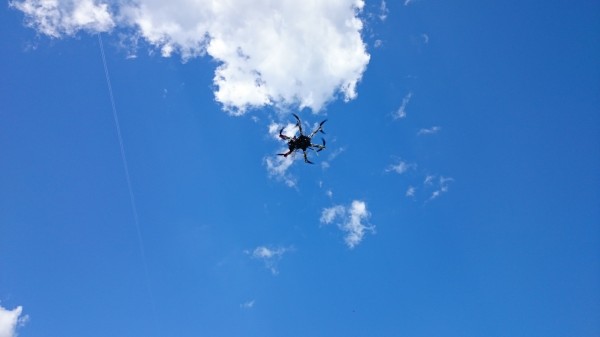In a rare ruling, the FAA has granted Olin College a research exemption to fly unmanned aircraft systems, (UAS) or drones as they are commonly called, to “conduct research on its own behalf and on behalf of other research groups.” Olin is one of a just a handful of schools to get this kind of exemption. It couldn’t have come at a better time for the Olin Robotics department and, in particular, Professor Andrew Bennett and his team of students.
Bennett recently received a call from Scientific Systems, a company that specializes in developing products that “collaboratively accomplish missions in difficult environments.” With some NASA-funding to pay for it, executives asked for help in figuring out a way to use drones to aid in fighting wildfires. Specifically, Bennett and his team were asked to work on a system where drones can be deployed into a wildfire and send back information in real time, potentially saving lives and livelihoods in the process.

Right now, firefighters receive information on where a fire is headed in a variety of ways including from pilots and first-hand accounts. They use that information to decide where to deploy fire bombers, personnel, and other resources. The problem is the data can be 12-24 hours out of date and is often unreliable. In addition, in an environment where driving conditions can be treacherous and the Internet non-existent, it can be impossible to communicate. So, if a fire shifts course, the firefighters may be unprepared to quickly move resources to a new location.
The Olin team is working on a proof of concept where several drones can communicate to each other while flying in dangerous conditions and, most importantly, send back data immediately. It should be noted that the aim of this project is to help fight fires using drones, instead of hindering the process as has happened recently with consumer drones flying into the flight path of air tankers in California. When they are ready for implementation, Bennett’s drones will fly in coordination with fire bombers.
Bennett’s drone “team” is particularly effective at designing and deploying drones in less than ideal flying conditions. For the past several years, they have been working on SnotBot, which is a drone that collects whale blow via a sponge-like attachment on its underside. As it flies over a whale, the drone captures the mucus and flies back to a boat. The testing for that project involved thousands of flights over water, and sometimes in it. SnotBot will allow scientists to learn more about whale stress levels. A Kickstarter campaign created by Ocean Alliance, another Olin partner, was recently fully funded.
The firefighting drone project is currently in its testing phase.
Source: Franklin W. Olin College of Engineering
Was this article valuable?
Here are more articles you may enjoy.


 Johnson Controls Unit to Pay $750M to Settle ‘Forever Chemicals’ Lawsuit
Johnson Controls Unit to Pay $750M to Settle ‘Forever Chemicals’ Lawsuit  National Crime Report Shows Vehicle Thefts Surged to More than 1 Million in 2023
National Crime Report Shows Vehicle Thefts Surged to More than 1 Million in 2023  Supreme Court Allows More Transport Workers to Bypass Arbitration and Sue Employers
Supreme Court Allows More Transport Workers to Bypass Arbitration and Sue Employers  Dog-Related Injury Claim Payouts Hit $1.12B in 2023, Report Shows
Dog-Related Injury Claim Payouts Hit $1.12B in 2023, Report Shows 